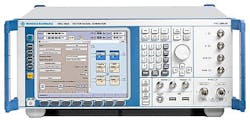Rohde & Schwarz enhances test and measurement equipment to evaluate performance of military radio
MUNICH, Germany, 14 March 2012.test and measurement specialist Rohde & Schwarz in Munich, Germany, is adding functionality to the company's R&S SMU200A vector signal generator to enhance the unit's ability to test military radio communications equipment. The company's R&S SMU-K77 option enables the SMU200A to test military radios under harsh receiving conditions such as dynamic fading and multipath signal propagation.
The vector signal generator's ability to perform fading simulation enables precise and repeatable tests in the lab and eliminates the need for expensive field or flight tests, Rhode & Schwarz officials say.
The R&S SMU200A vector signal generator offers the necessary tools to generate the desired test signals and interferers, and to simulate a radio channel. Together with the R&S SMU-K77 option, the R&S SMU200A supports high Doppler speeds and dynamic scenarios such as tower-to-aircraft mode; ship-to-ship mode; and user-defined mode.
The R&S SMU200A vector signal generator enables users to select predefined communications standards and define custom modulation modes, as well as create, load, and play arbitrary waveforms, such as those generated with the MATLAB tool from The MathWorks.
Military radio communications operates primarily in the VHF/UHF range, Rohde & Schwarz officials explain, which in the past used only small bandwidths of only a few kilohertz and typically analog modulation modes. This has gradually changed to include digital modulation such as phase shift keying (PSK) or quadrature amplitude modulation (QAM), which use several hundred kilohertz. Channel simulation and fading have been minor issues, since the narrowband analog signals were able to resist this kind of interference.
Modern military communications systems, by contrast, are no longer immune to multipath and fading effects. Today, it is beneficial to verify the performance of radio equipment using channel and fading simulators during development and qualification, and communications standards and hardware must match operations conditions.
Complicating matters is the lack of fixed test standards for military communications equipment, which forces manufacturers to undergo expensive tests or rely on past design experience, which can be risky.
The R&S SMU200A vector signal generator has a frequency range from 100 kHz to 2.2/3/4/6 GHz for its first RF path, with an optional second RF path operating to 2.2 or 3 GHz. The dynamic scenario simulation option is also available for the R&S AMU200A baseband generator and fading simulator (R&S AMU-K77).
The R&S SMU200A and the R&S AMU200A support standards such as EUTRA/LTE, 3GPP FDD/HSPA/HSPA+ and WiMAX, and include a baseband generator with a real-time coder and an arbitrary waveform generator.
For more information contact Rohde & Schwarz online at www2.rohde-schwarz.com.
Follow Military & Aerospace Electronics news updates on Twitter

